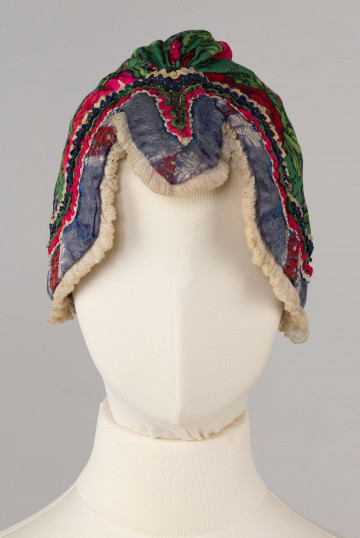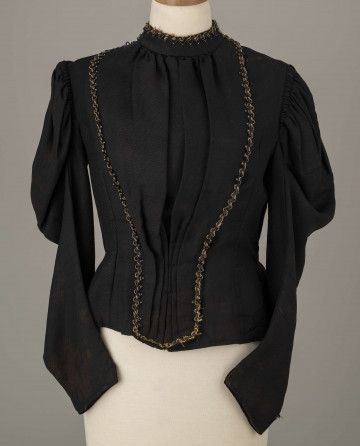
Men's trousers
1922 — 1942
National Museum in Lublin
Part of the collection: Folk craft of the Lublin Region (19th/20th c.)
Sukmana from Okopy in the Chełm region is an outer garment worn throughout the year, mainly by men, for a festive dress. It is produced from self-made cloth woven from wool and wrapped to pulverise and partially thicken the fibre structure. The process made the material stiff and impermeable but also very heavy. Dresses were sewn by small-town or itinerant tailors who carried out their work in the customer's home, which required the tailor to be hosted for several days and paid in cash or natural resources (crops). Cloths had the cut of an oblong poncho with two gussets sewn in from the waist down to widen them. They were slightly cut at the waist by the introduction of side darts, in which pockets were sometimes concealed. For ease of movement, small wedges were also used under the armpits at the sleeves. The dress decoration is a red woollen cord sewn on at both edges, at the small collar, along the opening to the waist, at the side seams and at the edges of the sleeve cuffs. This type of clothing was worn in the northern part of the Chełm region, where decorations in green or blue were popular. In the villages closer to Chełm and the southern part of the region, the dresses were made of white and dark brown cloth, and they were also fitted at the waist, had three folds at the back and a narrow collar similar to a stand-up collar. They were decorated with a red and blue woollen cord, which covered the same places as the first type, but additionally had trimmings in the form of the so-called small tassels. In addition, the lining of sleeves and pockets could be trimmed with red factory cloth.
In Poland, peasants wore sukmana as a sign of wealth because not everyone could afford it. The first time a man wore sukmana was for his wedding dress, and from then on, it was worn for all important church and state ceremonies. These clothes were highly respected and, if in good condition, were passed on to the next generation. In the Lublin region, especially in the western part, the wearing of sukmanas was abandoned already before the First World War and in the remaining areas in the middle of the 20th century.
Author / creator
Dimensions
cały obiekt: height: 58 cm, width: 120 cm
Object type
sukman
Technique
hand sewing
Material
cloth
Creation time / dating
Creation / finding place
Owner
The National Museum in Lublin
Identification number
Location / status

1922 — 1942
National Museum in Lublin

1880 — 1900
National Museum in Lublin

1900
National Museum in Lublin
DISCOVER this TOPIC
National Museum in Lublin
DISCOVER this PATH
Educational path